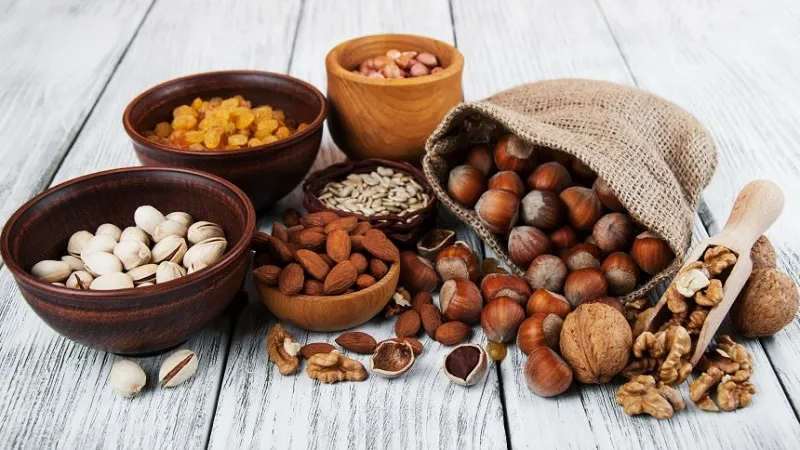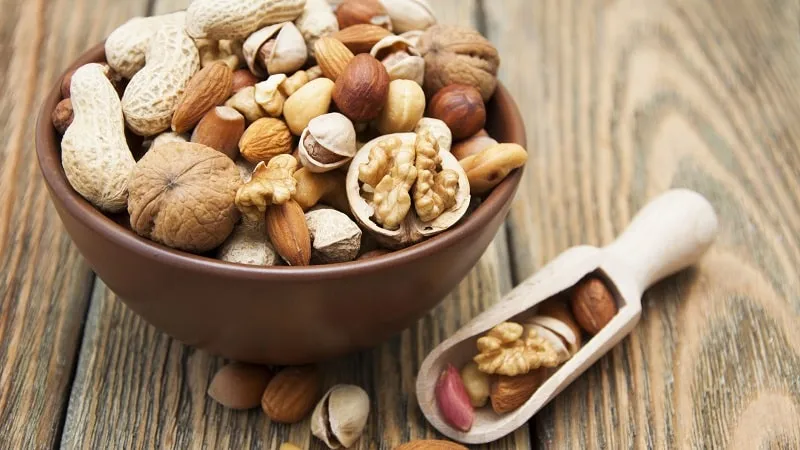Nuts are often considered high in calories and therefore undesirable in a weight-loss diet. However, this is a misconception—when consumed in moderation, certain nuts can actually accelerate weight loss while providing essential vitamins and minerals. Following simple guidelines for nut consumption can benefit anyone on a diet.
Table of contents
Can You Eat Nuts While Losing Weight?
Nuts are not excluded from a weight-loss diet but should be eaten in small quantities (up to 30 g per day). To help the body shed excess weight and reduce hunger, nuts can be added to salads, porridge, fruit and vegetable smoothies, cottage cheese, or eaten raw as a light snack.

Benefits of nuts in a diet:
- Lower LDL (bad cholesterol) levels and improve metabolism.
- Boost energy, especially after workouts.
- The fiber content aids digestion.
- High protein and fat content provide quick satiety during snacks.
- Magnesium, omega-3, and zinc support liver function, which is under stress during weight loss as it detoxifies the body from fat breakdown byproducts.
Nutritionists advise against eating nuts right before bedtime due to their high caloric density. The body won’t efficiently process large amounts of fats, proteins, and carbs overnight.
Important! Digesting nuts during sleep can disrupt rest quality, potentially leading to insomnia.
The caloric value varies between nuts, ranging from 550 to 700 kcal. High-calorie nuts (macadamia, pecans, pine nuts, and Brazil nuts) should be limited—if consumed, halve the daily portion.
Caloric and Nutritional Content of Nuts
To understand their value and differences, let’s compare several types. We’ll highlight key minerals and vitamin C, which play a role in weight loss.
Caloric and nutritional table per 100 grams:
| Nut Types | Calories, kcal |
Fats, % |
Protein, % |
Carbs, % |
Potassium, mg |
Magnesium, mg |
Iodine, µg |
Vitamin C, mg |
| Peanuts | 552 | 45.2 | 26.3 | 9.9 | 658 | 182 | 2 | 5.3 |
| Pistachios | 560 | 45.3 | 20.2 | 16.6 | 1025 | 121 | 10 | 5.6 |
| Cashews | 600 | 48.5 | 18.5 | 22.5 | 553 | 270 | 11.1 | 0.5 |
| Almonds | 609 | 53.7 | 18.5 | 13 | 748 | 234 | 2 | 1.5 |
| Hazelnuts | 628 | 61.5 | 15 | 9.4 | 717 | 172 | 0.2 | 1.4 |
| Brazil Nuts | 659 | 67.1 | 14.3 | 4.2 | 659 | 376 | 0.02–0.10 | 0.7 |
| Walnuts | 656 | 60.8 | 16.2 | 11.1 | 474 | 120 | 3.1 | 5.8 |
| Pine Nuts | 673 | 68.4 | 13.7 | 9.4 | 597 | 251 | 2–25 | 0.8 |
| Pecans | 691 | 72 | 9.2 | 4.3 | 410 | 121 | – | 1.1 |
Key nutrients for weight loss:
- Iodine supports thyroid function. Hypothyroidism slows metabolism, hindering fat burning. Cashews, pine nuts, and pistachios are richest in iodine.
- Potassium prevents bloating and aids digestion. Deficiency causes constipation and fatigue. Pistachios lead in potassium content.
- Vitamin C breaks down fats and enhances iron absorption, vital for detox and energy conversion. Walnuts, peanuts, and pistachios are top sources.
- Magnesium accelerates fat metabolism. Brazil nuts (376 mg) should be limited to 1–2 daily.
Best Nuts for Weight Loss
A diet shouldn’t mean starvation—it’s about balanced nutrition and metabolic health. Moderate nut consumption curbs hunger and delivers nutrients.
Note! Just 3–4 walnuts (50 g) equal 100 g of white bread (265 kcal) in satiety.
Top nuts for diets (raw or added to meals):
- Almonds (609 kcal, 53% fat) reduce cholesterol and provide vitamin E (173% DV) and iron (29%).
- Walnuts (656 kcal) offer vitamin C for metabolism, despite high fat content.
- Hazelnuts (628 kcal) are fiber-rich (44% DV) with vitamin E (117%) and omega-6.
- Peanuts (552 kcal) are lowest in fat (45.2%) and high in vitamin C.
- Cashews aid thyroid-related weight issues (11.1 µg iodine) with a glycemic index of 22.
- Pistachios (560 kcal) excel in potassium, vitamin C, and iodine.
Can you lose weight on nuts alone? No—a balanced diet is essential. Overconsumption risks fat storage and health issues.

How to Eat Nuts in a Healthy Diet
Follow these rules to enjoy nuts without weight gain. Excess fats won’t accumulate if you stay within 20–30 g daily, split across meals or eaten at once.
Important! Track nut calories in your daily intake—even a small snack adds 100–200 kcal. Balance proteins, fats, and carbs carefully.
Weight-loss tips:
- Avoid nuts in early diet phases. Introduce them during stabilization for nutritional support.
- Skip flavored varieties (salted, honey-roasted, etc.). These spike appetite and cause water retention.
- Rotate nuts in veggie/fruit salads for variety and nutrition.
Recommended Portions
Without a scale, stick to ~30 g daily. Approximate servings:
- Hazelnuts — 8–10;
- Walnuts — 6 halves;
- Cashews — 9–10;
- Almonds — 12;
- Pistachios — 40;
- Peanuts — 20.
Best Time to Eat Nuts
Timing matters for weight loss. High-calorie foods are best eaten earlier. Nuts in breakfast (salads, yogurt, porridge) prolong satiety.
Tip! For lunch, save nuts for a 1–4 PM snack to curb hunger.
At night, limit to 1–2 nuts 2–3 hours before bed (4 hours for high-calorie types). This beats sweets but avoids fat storage or sleep disruption.
Nuts as a Weight-Loss Snack
Most diets include snacks to prevent overeating. Nuts are ideal for mid-morning snacks.

Use high-calorie nuts raw just once daily. Mix types if adding to meals—e.g., pistachios at breakfast, walnuts at dinner.
Benefits:
- Quick healthy fat intake;
- Hunger suppression;
- Brain function boost, reduced dizziness;
- Fiber for digestion.
Risks:
- Obese individuals should halve portions;
- Oxalates may cause kidney stones if overeaten;
- Heavy for acute digestive issues.
Conclusion
Different nuts vary in calories and nutrients—key for diet planning. In moderation, they curb hunger and deliver vitamins. Add them to meals or enjoy as snacks for balanced weight loss.







